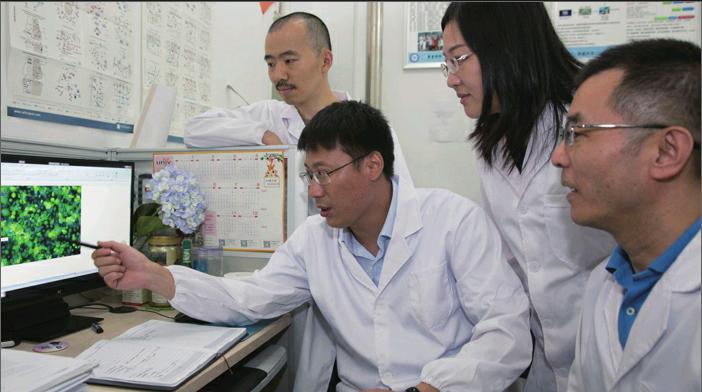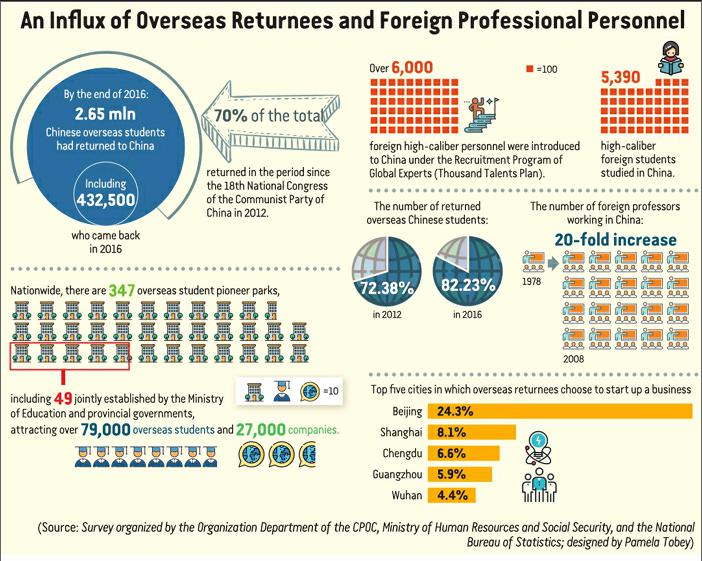RETURN FOR DREAMS
2017-10-20ByLuYan
By+Lu+Yan


After graduating from Peking University with a masters degree in bio-inorganic chemistry in 1995, Wang Junfeng decided to continue his studies in the United States. From 2004 to 2009, he did his postdoctoral work at Harvard Medical School, during which time his research articles were published in top-notch science journals such as Nature.
Eight years ago, Wang made a bold decision. He came back to China and began working at the Hefei Institutes of Physical Science under the Chinese Academy of Sciences (CASHIPS) in Hefei, capital of east Chinas Anhui Province.
“It was indeed a hard choice for many Chinese researchers overseas, to choose whether to continue to stay in a foreign country or go back to China,” Wang said. The dilemma was that the worlds most advanced equipment and good research conditions were available in the U.S., while in China, there was an explosive and unprecedented development in science and technology, providing huge opportunities and possibilities.
In the past two decades, as Chinas economy boomed, the country has attached increasing importance to science and technology, making it a more attractive base for researchers. Many high-caliber personnel like Wang choose to come back and seek opportunities in their home country.
“I chose to follow my instinct and come back, ready to go for it,” Wang said.
Team work
In most peoples eyes, Wang was enjoying a prosperous career in America due to his Harvard postdoctoral research and the recognition it gained. But he saw it differently.
“People say that I ‘gave up the so-called‘privileged life, but that was not the case,”Wang said. He had neither his own largescale scientific facility, nor a strong team to work with, which are crucial for independent research. He said although he was leading a relatively comfortable life in the U.S., he could always feel there was a glass ceiling above his career, and that something was missing.
A chance meeting with Kuang Guangli, Secretary of the Communist Party of China(CPC)CASHIPS Committee, changed Wangs life. Kuang introduced to Wang the future plan of CASHIPS, which was still at a fledging stage in 2009, to build advanced experimental equipment to create steady high magnetic fields, which, like super low temperatures and super high pressures, create an extreme environment for scientific experiments. In such high magnetic fields, the structure of matter changes, presenting different physical and chemical effects, which can provide new possibilities for further scientific research and development. Wang could see the prospect of CASHIPS building the worlds top steady high magnetic fields generator. But at that time, what the program lacked most was qualified personnel.endprint
Having such a grand blueprint presented to him, Wang was tempted. “Although it was no more than an idea, I could still see a bright future out of it,” he said.
In August 2009, Wang, together with his wife and two children, boarded a plane to China. Several hours later, they arrived at CASHIPS, which also has another, much more vivid name—Science Island. He was immediately impressed by the scientific research atmosphere there. “I told myself that this is exactly what I want, a place where I can devote myself to my research work,” Wang remembered.
But it was not all plain sailing at the Science Island at the beginning. Wang didnt have a space to carry out scientific research or sufficient equipment. He had to build everything he needed from scratch.
Wang took the first step by inviting fellow Chinese scientists whom he had worked with at Harvard. Liu Qingsong was the fi rst to accept the invitation. Unlike Wang, Liu was working on several research projects at Harvard and wasnt thinking about returning to China.
When Liu was visiting Wang at the Science Island in 2010, he was surprised by the fine scenery and tranquil surroundings. He also met Kuang, who told him something that struck a chord. “Liu, youre 32 years old now, the same age as me when I came back from my studies in Germany and settled down here at the island, ready to start my own undertakings,” Kuang said.
Liu became the second Harvard postdoctoral researcher at CASHIPS. Two years later, he brought his wife, Liu Jing, who was also a postdoctoral researcher, specializing in pharma- ceutical chemistry at Harvard Medical School.
Later on, five other Harvard researchers joined the organization. None of them is from Anhui, but they have gathered together with the same enterprising spirit to form a strong team.
“Our research areas form a complete research chain at CASHIPS, working on both magnetobiology and cancer studies,” Wang said.
Equipment for conducting experiments using magnetic fields was put into operation in 2010 and has been breaking worlds records ever since. CASHIPS has become a venue for experiments for more than 400 colleges, universities, research institutes and companies nationwide, covering over 1,200 experimental subjects. It also provides huge possibilities for the eight Harvard scientists.
Zhang Xin, one of the eight made a comparison. “What I did in the U.S. was traditional biological studies, while here I can enjoy better hardware facilities.”endprint
In November 2016, a magnet designed and built at CASHIPS reached full capacity, becoming the second strongest steady fi eld magnet in the world.
The overseas returnee team at CASHIPS is not an exclusive club for only eight persons. “We sincerely hope that more scientists like us can join us,” Liu said. “Now, as China is progressing fast, it has become a center of high magnetic fi eld research, attracting professionals who have studied in foreign countries to come back.”
A megatrend
Construction began on the Science Island in 2008 as one of the major national science projects supported by the National Development and Reform Commission.
“The country is strengthening its support for science research and development, both in terms of capital and policy,” Xie Xiaoliang, Mallinckrodt Professor of Chemistry and Chemical Biology at Harvard University, member of the U.S. National Academy of Sciences, and Professor of Life Science at Peking University, told Beijing Review.
Lu Shijia was one of Xies doctoral students at Harvard, specializing in single-cell sequencing. She came back to China after graduation and started her own business, which has grown into an elite team of 230 researchers and scientists. “Now there are more people in her team than in mine at Harvard or Peking University,” Xie joked.“Now its getting increasingly easier for people like Lu to find investment, and the government is providing support in upgrading ancillary facilities.”
Since the 18th CPC National Congress in 2012, China has sped up its steps to build a qualified-personnel system with international competitiveness.
In September 2012, China launched the Ten-Thousand Talents Program, which plans to select about 10,000 outstanding personnel in the fields of natural science, engineering, technology, philosophy and social science in the following 10 years and provide them support including 1 million yuan ($152,800) to fund research and expert team building.
Chinese President Xi Jinping said at the 100th anniversary of the Western Returned Scholars Association in 2013 that the government will give great impetus to the implementation of the Ten-Thousand Talents Program and that China supports students and scholars studying abroad, encourages them to return to China, guarantees them the freedom of coming and going, and supports them in using their talents.
Besides presenting an alluring offer for high-level personnel who have studied abroad to come back by providing favorable conditions, China has also introduced plans to attract more foreign scientific professionals to pursue their careers in the country.endprint
In 2008, China initiated the Recruitment Program of Global Experts, known as the Thousand Talents Plan, under which it would bring in overseas top talents to China over five to 10 years. Relying upon National Key Innovation Projects, National Key Disciplines and National Key Laboratories, central state-owned enterprises and state-owned commercial and financial institutions, and various industrial parks (mainly the hi-tech development zones), this plan called for strategic scientists or leading talents who could make breakthroughs in key technologies or enhance Chinas hi-tech industries and emerging disciplines.
A number of programs serving similar purposes have been carried out, not only at the government level, but at regional and organizational levels, which to some extent free qualified personnel from worrying too much about capital, staff and project planning and help them concentrate on their scientific work.
According to a survey jointly conducted by the Organization Department of the CPC, the Ministry of Human Resources and Social Security, and the National Bureau of Statistics, by the end of 2016, 2.65 million Chinese overseas students had returned to China, including 432,500 who came back in 2016. Over 6,000 foreign high-caliber personnel were introduced to China.
“Returned high-caliber personnel have played a key role in the great rejuvenation of our country,” Liu Limin, Vice President of the Western Returned Scholars Association and Chairman of the China Education Association for International Exchange, told China Education Journal. “China is in need of them more than ever, and has the ability and conditions to attract them more than ever.”endprint
